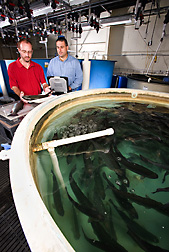This page has been archived and is being provided for reference purposes only. The page is no longer being updated, and therefore, links on the page may be invalid.
| Read the magazine story to find out more |
|
See our information kit to find out more. |
|
Recirculating Water Systems Used for Fish Production
By Sharon DurhamOctober 20, 2010
U.S. Department of Agriculture (USDA) scientists in West Virginia and Maine are working closely with a collaborator to save water as part of an effort to develop recirculating water systems for cool- and cold-water fish production.
Scientists with USDA's Agricultural Research Service (ARS) at the National Center for Cool and Cold Water Aquaculture (NCCCWA) in Leetown, W.Va., and the National Cold Water Marine Aquaculture Center (NCWMAC) in Franklin, Maine, partnered with Steven Summerfelt of the Conservation Fund's Freshwater Institute in Shepherdstown, W.V., to discover the best ways to produce fish that live in cool and cold water in a closed system.
ARS is USDA's principal intramural scientific research agency. This research supports the USDA priority of promoting international food security.
The recirculating system Summerfelt developed doesn't just move water around. It uses as little as 4 percent new water each day, which means that a complete water exchange only takes place every 25 days. According to Summerfelt, this miserly use of water—an environmental plus—also allows recirculating fish farm systems to be located in many places where traditional aquaculture wouldn't work.
William Wolters, director of NCWMAC, found that the systems developed for his facility's particular needs are working well. Because Franklin has limited groundwater resources, a system that reuses water was crucial. The recirculating systems have allowed the researchers to raise their fish efficiently with a limited amount of water.
In Leetown, W.V., scientists led by Caird Rexroad III at the NCCCWA are working with trout, a fish that needs especially pristine water in order to live and thrive. Twenty years ago, it was believed that trout couldn't thrive in a water recirculating system. Particularly sensitive to water quality, they will not eat enough feed to grow if conditions aren't right.
The recirculating systems developed for the cool and cold aquaculture fish have several advantages over current systems, according to Summerfelt. Because they require far less water and capture the wastes, a fish farm that recirculates its water can be located far from large water bodies and near consumers. This gets fresh fish to market faster and with less transportation costs.
Read more about this research in the October 2010 issue of Agricultural Research magazine.

